Paul Draper’s forty years and the making of Ridge Monte Bello
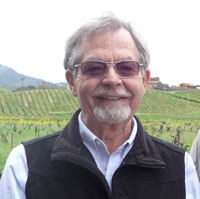 Paul Draper is, without question, one of the world’s great winemakers. Even though he has every reason to be an egotistical blowhard, he remains humble and democratic in spirit, asking sincere questions of those around him and quick to point to his team as the reason for the winery’s success. It may sound absurd to think that a winemaker’s personality is as discernible in the glass as the terroir, but that combination of curiosity, humility, and respectful excellence comes through in the wines of Ridge Vineyards.
Paul Draper is, without question, one of the world’s great winemakers. Even though he has every reason to be an egotistical blowhard, he remains humble and democratic in spirit, asking sincere questions of those around him and quick to point to his team as the reason for the winery’s success. It may sound absurd to think that a winemaker’s personality is as discernible in the glass as the terroir, but that combination of curiosity, humility, and respectful excellence comes through in the wines of Ridge Vineyards.
Presiding over forty harvests at Monte Bello in the Santa Cruz Mountains, the winemaker and CEO at Ridge, has seen an almost unparalleled run of excellence. It is rare among the top producers of the world not to hit a rough patch, where something just stops working for a string of vintages. But after tasting several dozen wines from vintages dating back to 1968, it’s clear to me that from vines grown on the fractured limestone, Ridge Monte Bello has been able to achieve this rare feat.
The road to Monte Bello
Born in 1936, Draper’s father was hit hard by the depression and returned to a farm outside of Chicago (Barrington, IL, is now a suburb). He eventually went to Stanford where he studied philosophy; he later worked for the US government in Italy and made some wine in Chile before being hired by the four partners of Ridge—all Stanford engineers—in 1969.
The four-and-a-half mile road to Ridge starts as two lanes. The ear-popping ascent from the floor of Silicon Valley winds under moss-covered trees, eventually becoming decidedly too small for two cars to pass. That’s about when the first vines appear.
As I arrived at the upper winery one day last week, about 2,600 feet in elevation, the rain was falling. There was Paul Draper to meet me and the dozen other journalists and members of the trade attending the tasting, celebrating the 50th anniversary of Ridge.* Wearing a Gore-Tex shell, and sporting his signature trim goatee with his polarized glasses, dark in the cloudy glare, Draper smiled warmly.
We went into the cool Monte Bello barrel room where we were given two unmarked glasses. Monte Bello, the estate’s top wine, is a blend of mostly Cabernet Sauvignon and some Merlot, but also, in some vintages, some petit verdot. In our two glasses of the just-blended 2009 Monte Bello, we had to discern which one had just 0.9 percent more of one element than another.
The labels that adorn bottles of Ridge wines are models of precision. Retro-chic all-caps, blare the vineyard site; smaller font highlights each grape variety’s contribution to the blend. But nothing is as small as 0.9%. It turned out that the wine that had slightly more lift included the addition of a small amount of press wine. Almost everyone in our group preferred that wine. And it was also the current blend Draper & Co. had chosen.
Fine tuning the blend
The blending process at Ridge occurs in stages. In the February after harvest, most of the wines have completed their secondary (malolactic) fermentation. A group of ten tasters from the winery sits down to blind taste about five flights of six wines, which come from the individual vineyard plots, fermented separately. Each one is given a thumbs up or a thumbs down to qualify for the final blend. (Draper and the Monte Bello winemaker, Eric Baugher, and Lytton Springs winemaker, John Olney, admitted that their votes weigh more.) Interestingly, it is a relative way since only three from each flight can pass to the final round. In this way, each vineyard or block has an equal shot to reach the final wine. In a process known as assemblage, the various samples are then blended and set aside for another few weeks, when a second and final blend occurs.
A crucial part of achieving the consistency at Ridge Monte Bello remains the blind tasting of the various parcels. Draper said that they have also added a blind tasting of previous vintages against the final wine to assure consistency in house style from year to year, something that had escaped them one year in the 1980s.
We got to play along with the assemblage, tracing the blending process in five glasses. The first glass was a big, tight, highly structured wine, St. Estephe-like in its tannins; turns out it was 76% cabernet sauvignon and 24% merlot. Glass two saw the addition of 11% something else that added floral (lavender) aromas—turns out that was 11% petit verdot. The third glass moderated the aromatics but give the wine more depth on the palate—this addition was a dollop of cabernet sauvignon from the Steep Terrace parcel, which almost always makes it in the blend. Another shot of cabernet added more acidity and a final bolt of 7% surprisingly tannic merlot made the 2009 Monte Bello tapestry complete (for now since there’s a final blend assembled in May). The resulting wine, although still tightly wound, has excellent, depth, complexity and aromatic appeal.
The wines that do not make the top wine either end up in the Santa Cruz Mountains wine. At a list price of $42 (although often available from retailers for less), these are quite serious wines for at least a third the price of Monte Bello. The 2006 red has pretty aromas and is approachable now despite a sold core of fine tannins; the 2007 was more tightly wound at this stance and a more serious wine.
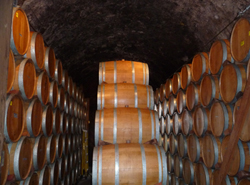 Curiously, the wines age in American oak barrels, rather than the French oak that acts as a vessel for many of the world’s top cabernets for their first year or two. Draper said that the site provided a European style of fruit and that with French oak, the wines would be mere imitations of Bordeaux and that wasn’t what he was seeking to do. The team at Ridge works with French coopers to source the wood from three forests of quercus alba (white oak) across the US (he wouldn’t reveal which, citing scarcity of the wood). The staves are aged outdoors near the forest of origin for two years, which provides many cycles of wetting and drying to leech out the harshest elements of the wood. (Coopers had tried to bring the wood to California for aging but it was too dry in the summer for Draper’s taste.)
Curiously, the wines age in American oak barrels, rather than the French oak that acts as a vessel for many of the world’s top cabernets for their first year or two. Draper said that the site provided a European style of fruit and that with French oak, the wines would be mere imitations of Bordeaux and that wasn’t what he was seeking to do. The team at Ridge works with French coopers to source the wood from three forests of quercus alba (white oak) across the US (he wouldn’t reveal which, citing scarcity of the wood). The staves are aged outdoors near the forest of origin for two years, which provides many cycles of wetting and drying to leech out the harshest elements of the wood. (Coopers had tried to bring the wood to California for aging but it was too dry in the summer for Draper’s taste.)
But the real magic of the winemaking is the fact that there is no magic: winemaking occurs with a non-interventionist approach. In an age when commercial yeasts fire the fermentations of a vast majority of the world’s wines, the Ridge wines all occur with only the natural yeasts. Some say that is risky, but at Ridge it is an integral a part of the program. The yeasts appear in the winery and on the skins of the grape; damaged berries get put in the crusher since they are likely to have an abundance of yeasts as they attracted insects on the vine. There’s no micro-oxygenation and no reverse osmosis. The wines resulting from this winemaking are big and flavorful but also gracefully low in alcohol, always under 14%.
In the glass
And how do they age? Gracefully. We tasted fifteen vintages of Monte Bello over the course of one day and had no clunkers. The younger vintages are all tightly wound and will reward with more than a decade of cellaring; the world’s best cabernet assumes a delicacy and refinement that make it very much worth the wait. Of the younger releases, the 2005 stood out as particularly gorgeous with fresh acidity, minerality and youthful tannin under a seductive wrap of dark fruit.
Of the mature Monte Bellos, the legendary 1970 exhibited a gorgeous nose of delicate tobacco with the wine in a lovely place, mature yet still very much alive. This was my favorite of the pre-1990 wines and my second favorite of the night. The 1988 was really sublime with aromas of alluring mint and tobacco and a pinot-like delicacy. It had extraordinary length; I would like to try against top Bordeaux of the same vintage. The 1992 was also a superlative wine showing beautifully. The 1968 was served at the end of the meal with blue cheese. It was not port-like but, then-winemaker David Bennion left it on the lees for extended periods. Rich and ripe and mature it was a rare treat still showing impressively.
But the wine of the night, in my view, was the 1991. This wine has all the pleasure of top cabernet with age from a superior vintage and producer. That evening, it showed a multilayered subtle elegance, with a beautiful blend of mature fruit. The wine’s beautiful arc lingers impressively.
* For those who enjoy the full disclosure policies of this blog, I paid for my ground transportation on both ends of my trip, as well as my flight; Ridge paid for the hotel and meals. The wines were all from their cellars.
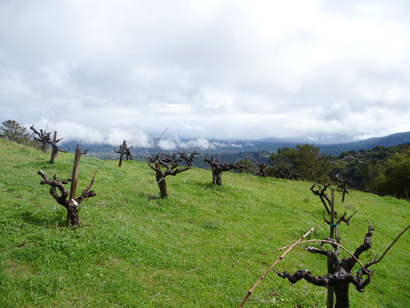
60-year-old cabernet vines at Monte Bello Ridge
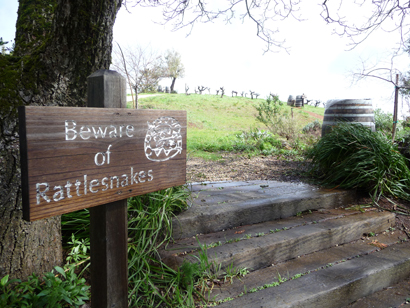
Vineyard hazards!
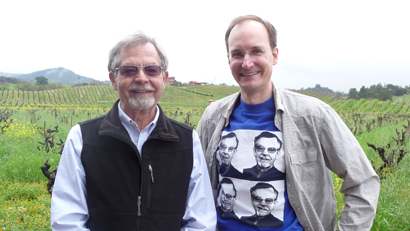
With Paul Draper, both live and on the tshirt from Terroir wine bar in New York City. Draper told me that he went to Terroir where the server, upon seeing him, said that he looked better than in real life than he does on his tshirt. I’m sure that happened to Che all the time too.
Coming up in a future post, answers to the question: can Zinfandel age gracefully?
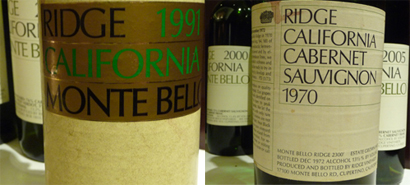




On March 9th, 2010 at 2:44 pm ,StockJockey wrote:
Great Post. I was always partial to the ’85 Monte Bello, mostly because of one great bottle.
SJ
On March 9th, 2010 at 8:18 pm ,Eric Guido wrote:
Great article. I love RIDGE and this was a wonderful, detailed look into their 2009 tasting. I’m also a Monte Bello collector that never has the chance to make it to their tastings but your piece almost made me feel like I was there.
The background on Draper was much appreciated as well. Thanks.
On March 9th, 2010 at 8:34 pm ,Peter Grant wrote:
Great article. I wish I could do a tasting like that!
On March 9th, 2010 at 8:51 pm ,chris robinson wrote:
Draper isn’t just a great wine maker, he is probbaly the greatest blender of varietals bar none. The Zins are always remarkable blends and the Monte Bello just a serious wine drinker’s thought piece. And how was the MB 1993? Sadly the only one I had was corked.
On March 9th, 2010 at 11:16 pm ,Robbie C. wrote:
It’s awesome to see this shout-out to Paul Draper. I was just looking up info on him a week or two ago because I hadn’t heard anything about him for awhile (and I haven’t had a Ridge wine in a couple years since I can’t find them in China) I really miss drinking these wines! It was a Ridge wine that really got me interested in wines (and in paying more than $20 for a bottle of wine)
I occasionally go to the Ridge website just to look over the current releases and drool. The best Monte Bello I ever had was an 88′. The worst I ever had was an 83′ (could have been stored improperly because it came from an auction)
MMM, here I am drooling again. Tyler, I’m so jealous of your trip!
On March 10th, 2010 at 7:53 am ,Vladamir wrote:
Che was a murderous rampaging thug. Anyone wearing his image due to a misplaced notion of ‘coolness’ or the NYC ‘hipster quotient’ is an idiot.
Mentioning him in a wine blog is mindless as well.
On March 10th, 2010 at 9:53 am ,Dr. Vino wrote:
So glad you enjoyed the post! Stay tuned for Part II!
@ StockJockey – glad you have a sentimental attachment to a great wine!
@ Chris – we didn’t try the 1993. Have you tried every other vintage? I know you taste a lot of fine wine!
@ Robbie – the 88 was showing v well last week…Thanks for the kind words.
On March 10th, 2010 at 4:46 pm ,Alex wrote:
Thanks for the great report. Ridge is my favourite California winery, and the one which turned me on to the world of fine wine.
@Robbie – I lived in China for a few years and also suffered from Ridge-withdrawal. Only place I ever saw their wine was while travelling in the touristy town of Yangshuo. A nice cafe had a half-bottle of, if I recall, Ridge Santa Cruz Mountains Cabernet on their wine list.
On March 10th, 2010 at 11:32 pm ,Kimberly wrote:
When I saw the piece in last Wednesday’s NY Times Dining and Wine section about Ridge, I practically got heart palpitations. California Zinfandel has always been my very favorite wine to drink, and I’ve loved Paul Draper and Ridge Zinfandels for just years. He is a rock star, in my estimation.
On March 11th, 2010 at 5:23 pm ,Robert Millman wrote:
Tyler–this story may amuse you and your readers: Some years ago Robert Parker conducted a tasting of the 1991 California Cabs on their 10th anniversary for Executive Wine Seminars. As per usual we offered the wines that Mr. Parker had rated most highly. Paul Draper called me to ask why the Ridge Monte Bello–long a favorite wine of mine– was not included. I explained that the list of wines were those chosen by Parker not by my partner and I. He asked if we could include the 1991 Monte Bello as an extra and of course we did so. All 15 wines were tasted blind. I am sure you know what I am going to say: The Montebello came in 1st. I believe that it was among Parker’s 3 favorite wines. It was and is a magnificent example of Montebello at its best.
Bob Millman, Executive Wine Seminars
On March 17th, 2010 at 3:42 am ,tom merle wrote:
Robert M,
Does this mean that RB found the Monte Bello far better after ageing for a decade? Or were the 91s selected based on Mr. Parker’s preferences in 2001? If so, what does this say about his palate not including the MB in the initial list. Pretty confusing.
On August 2nd, 2010 at 1:20 pm ,“A Beaujolais-style Zinfandel” Paul Draper & Julia Child | Dr Vino's wine blog wrote:
[…] Paul Draper appeared on the program “Dinner with Julia” with Julia Child in 1983. As you might expect, he brought along some wines from his Ridge Vineyards. The trip back in time is complete when he offers Julia a Ridge, Amador, 1980 Zinfandel, which he describes as “a Beaujolais-style Zinfandel.” Watch the brief clip to catch a glimpse of Ridge White Zinfandel (who knew!) and to see what Paul pairs with artichoke and lobster! Permalink | Comments (3) | SHARETHIS.addEntry({ title: "“A Beaujolais-style Zinfandel” Paul Draper & Julia Child", url: "http://www.drvino.com/2010/08/02/beaujolais-zinfandel-paul-draper-julia-child/" }); | American wine This entry was posted on Monday, August 2nd, 2010 at 8:00 am and is filed under American wine. You can follow any responses to this entry through the RSS 2.0 feed. You can leave a response, or trackback from your own site. Aug 2 2010 3 […]
On September 17th, 2010 at 2:45 pm ,Jeff wrote:
Great topic. I met Mr Draper when I was invited for a tasting at Ridge by one of my attending surgeons when I was a resident. He was there in his usual outfit, extremely gracious and thoughtful. We tasted the 2000(not the final assemblage), 1997, and 1990 Monte Bello. By far my favorite was the 90, which was going for (and still is on their website) for $300/bt. I found a 6 pack online the next day for $360 total. Best purchase of my life!
On December 4th, 2010 at 8:34 am ,There’s Zin. And then there’s Ridge Geyserville. [mature wine] | Dr Vino's wine blog wrote:
[…] visit the property and talk with the cellar masters this past spring. Although I also tasted some spectacular wines of Monte Bello, I was looking forward to the tasting of old zinfandels dating back to 1973, including multiple […]